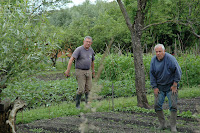Gardens in center of France



The marshes surrounding the small city of Bourges formed a barrier that protected early Celt and later Roman settlements from invasion. The vast marshlands inspired fear and superstition since those who entered would often become lost and would never be seen again.
But by the 8th century the Jesuit sisters of Charity had figured out that by digging channels through the marshes to the river, the land would drain and reveal a rich soil perfect for gardens. The church had the first gardens and fed the poor from their plots. After the French Revolution they became public and ordinary people began to garden there.
Today more than 1,500 privately owned garden plots bisected by canals surround the city. It's a place filled with birdsong with weeping willows bowing to the water, abundant flowers and early crops. The long April to October growing season means industrious growers can often have two crops.
It's been especially rainy in recent weeks here in central France so the canals leading to the two rivers that have their confluence in the middle of La Marais (marsh in French) are muddy and a walk down the gravel road through the gardens is puddled.
But the Marais teams with activity during our Thursday visit. School groups armed with nets catch frogs and insects and gather around their instructors to learn about them as gardeners till their plots, pull weeds and harvest asparagus, lettuces, radishes and other early spring crops.
The presence of wild calla lilies growing along canals and ditches reveals a climate somewhat milder than ours in Northeast Ohio.
Summers in Bourges mean concerts by an orchestra on a floating barge with bleachers all around. People bring picnics or have their dinner at one of the two restaurants at the edge of the Marais - sited where they are so their chefs can easily harvest produce for dinner.
Like spring everywhere, it's a season of new life. We see a swan on its nest, lots of mallard ducks and other water birds including a Moor Hen followed by its young in the water.
Gardens, which are passed down through families, are entered through gates - some of them dripping with roses or other flowers. Some gardens can be reached only by water and flat bottomed watercraft line the river banks for poling down canals. Garden cottages range from aging shacks to sweet little cottages, although amenities are limited by a lack of electricity.
Our guide, Barbara, an expat from Florida who is married to a French cardiologist, tells us the garden cottages hid Resistance fighters during World War 2.
It's a fascinating place that will be revisited in an upcoming Sunday Travel story about Bourges.
 RSS
RSS

0 Comments:
Post a Comment
Subscribe to Post Comments [Atom]
<< Home